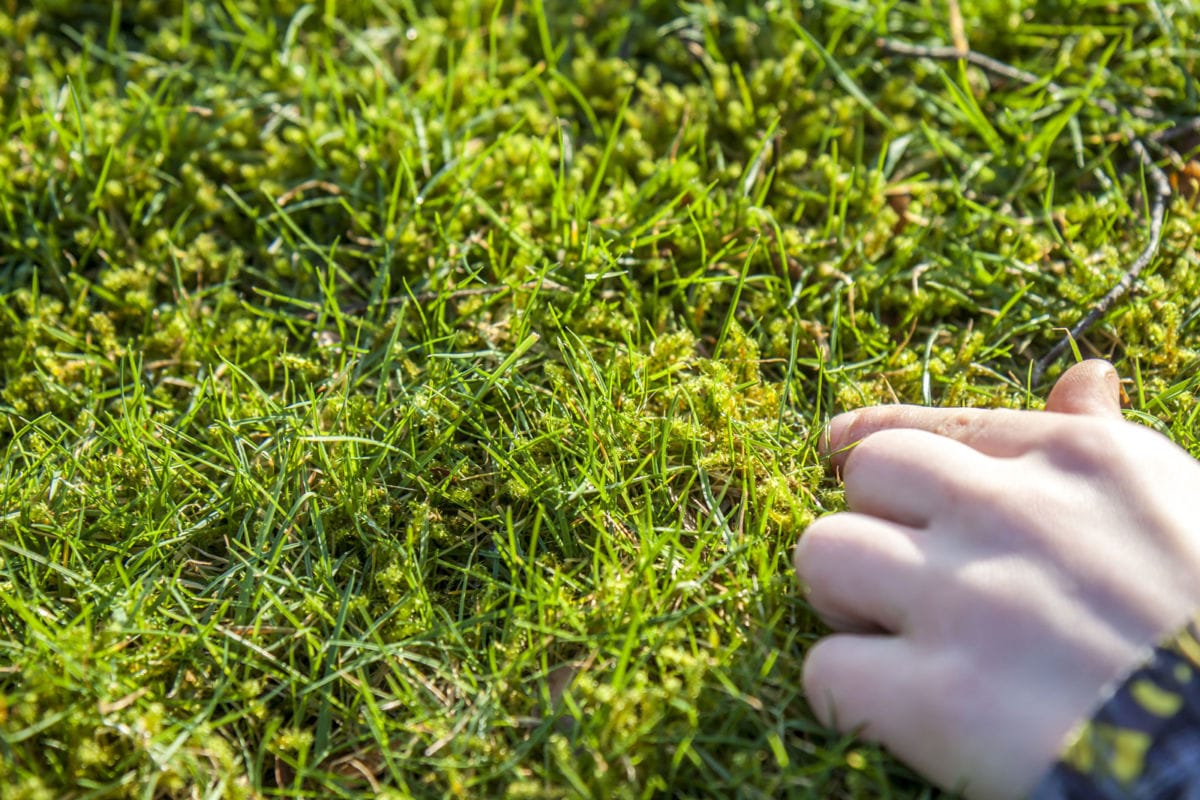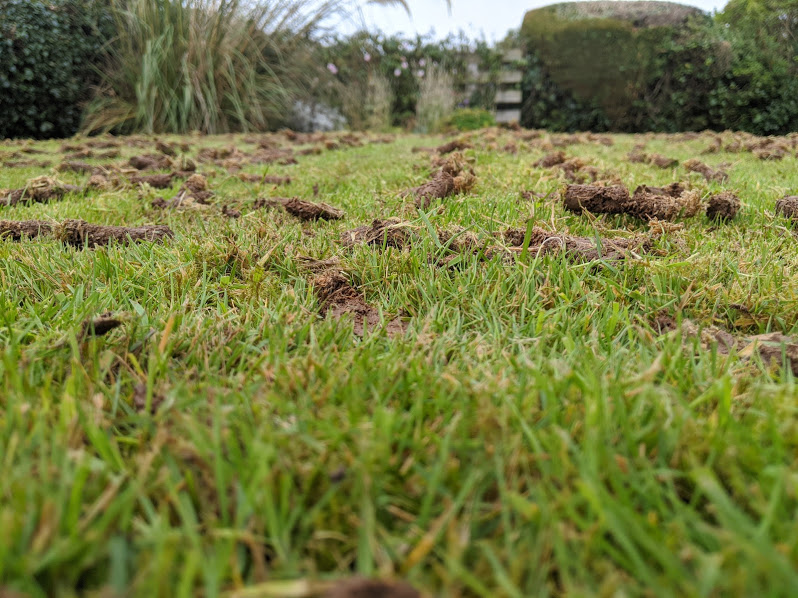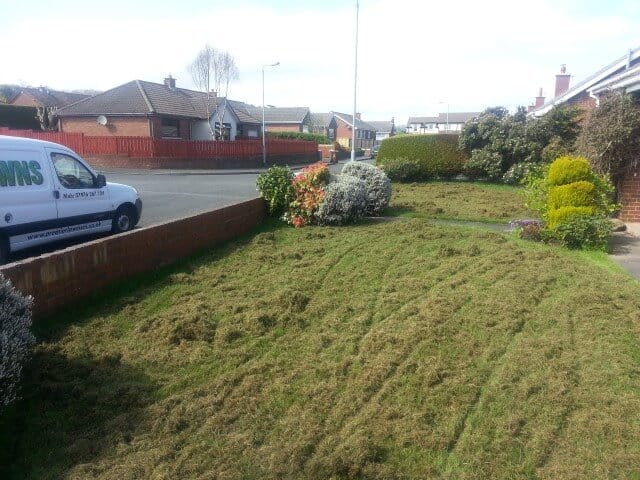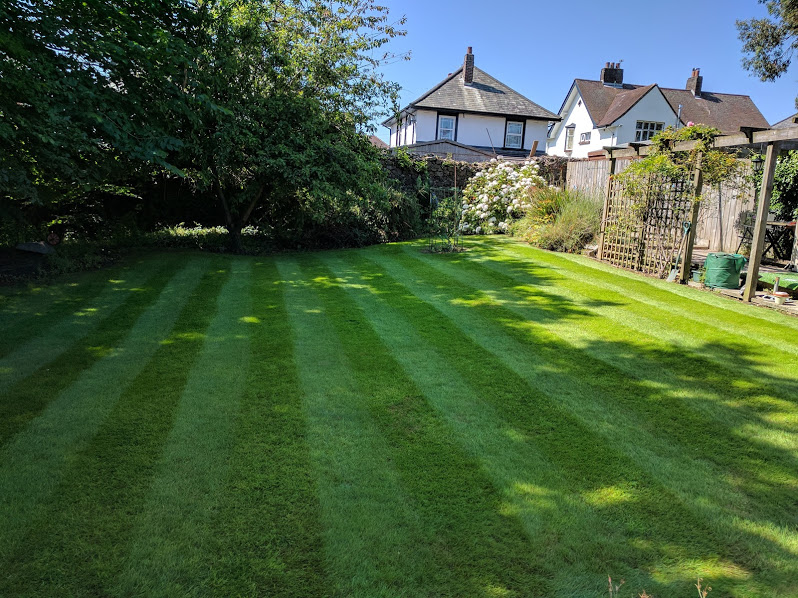Some of the most frequently asked questions on my You Tube channel are about moss. Here’s my step by step guide on how to kill moss in your lawn.
8 Steps To Kill Moss In Your Lawn
- Aerate the soil to make it less comfortable for moss to grow
- Scarify to clear away existing moss
- Treat your lawn with lawn sand, iron sulphate or your preferred moss killer
- Assess growing conditions in your garden
- Overseed with an appropriate grass seed mix to thicken up the sward
- Raise the cutting height of your mower
- Feed and treat your lawn regularly throughout the year
- Aerate, Scarify and apply moss treatments at least once a year – more if the moss is quite vigorous

Moss can quickly out compete the grass plants and changes the texture and durability of a lawn
Before You Begin
Before you start to kill moss in your lawn, it’s important to realise that this is probably going to be a long term project, and there is no ‘one size fits all’ solution. Moss is alive, and all it wants to do is grow and reproduce to keep its species alive. And let’s face it, from that point of view, it’s a very successful plant.
However, moss and lawn grasses are not made to live happily side by side. One will inevitably try to outcompete the other. Your job as a lawn lover, is to make sure that the grass is always going to be the winner. And to do that, you need to weaken the moss with every weapon in your arsenal. Starting with the growing conditions.
Moss NEEDS water to reproduce. It has a two phase reproductive system, one of which involves the male genetic material swimming through water to reach the female in order to form an embryo plant. So, it makes sense, that if your lawn is well drained, there won’t be as much water about to aid reproduction.
The other big thing to know about moss is that it has a very shallow, primitive root system. Unlike grass, It can’t access water from deep in the soil. Again, good lawn drainage will make life difficult for moss.
If you want to not only kill moss in your lawn, but stop it returning too, you ned to take a long term approach to managing soil water and to interrupting the life cycle of the plants so that they don’t manage to breed in your lawn. With billions of moss spores blowing in from other gardens every year, moss control is definitely an ongoing project.
Making Sure Your Soil Is Not Moss-Friendly
Aeration is a job that greenskeepers and lawn lovers carry out on a regular basis. It has several benefits – most of which are about making it easier for the grass plants to grow strong, healthy roots so that it can outcompete weeds, pests and diseases.
Your first point of attack if you want to kill moss in your lawn should be to aerate the soil to improve drainage and make it harder for moss to thrive.

Hollow tine aeration removes plugs of soil and creates small holes that allow water, air and nutrients to reach the grass roots. Happy roots = healthy grass
Scarification To Remove Moss
Scarifying is often done at the same time as aeration. It’s a bit like a deep clean for your lawn. Dead and dying vegetation is raked out our the sward along with loose moss and other debris.
There’s a three-pronged benefit to scarifying. First of all, it takes away the adult moss plants before they can reproduce. Secondly it helps the grass plants to breath and gives them room to grow. Thirdly – hidden amongst the thatch and debris that you remove will be millions of microscopic moss spores that have been sitting in your lawn waiting for the right moment to germinate. Now, you won’t remove all of them by scarifying, but you will certainly reduce the amount.

It’s amazing how much debris is lurking in your lawn. Scarification really does improve air circulation around the plants and make conditions less comfortable for moss.
Kill The Remaining Moss
You can scarify all you like but you will never remove every single piece of moss and/or every newly germinated spore. And so now is the time to apply your moss treatment. Not when you have lots of visible moss – that would be a waste of money because you can remove it without chemicals. Apply your moss treatment to clear up any stragglers.
Some moss treatments are also rather good at boosting the health of your grass. Iron sulphate for example does a wonderful job of making your grass much greener. Iron is one of the elements that plants use to create chlorophyll – the green pigment that helps harvest energy from the sun.
Before you buy a proprietary ‘off the shelf’ moss treatment, look for iron sulphate in plain bags. You can save yourself an absolute fortune by understanding the active ingredients and not falling for clever marketing tricks. A pretty box won’t make your lawn any greener!
Assessing Conditions In Your Garden
Before you buy any grass seed for the next stage of your journey to kill moss in your lawn, step back and assess the growing conditions.
Moss usually infiltrates lawns where the soil is damp. And where is soil most likely to be damp? In the shade of course, and in places where there is poor air circulation.
If you are able to, try to solve the shade and ventilation problems in your garden. Obviously, if your lawn is shaded by your house you can’t do too much about it. But you can prune trees and shrubs to let in more light and to let the air flow more freely.
Soil compaction is another attractant for moss. We have made inroads into tackling compaction by aerating your lawn. But if for example you take the same route across the lawn to the shed/washing line/patio on a regular basis, the soil there will quickly become compacted again. You could consider aerating it more often, or you could make a quick design change in your garden and install a path or stepping stones instead.
Perhaps you are finding that one part of your lawn is wetter than the rest nearly all year round? That would be a good place for moss to thrive. Can you do anything to improve the drainage? Is that part of the lawn lower than the rest? Can you build up the levels?

If your lawn is shaded your lawn care regime and will probably include regular apply treatments to kill moss
Overseeding Your Lawn
The reason I talked about assessing shade and damp in your garden, is that different lawn grass species like different growing conditions. Now that you have aerated and scarified your lawn, you are most likely going to see areas where the grass sward is either thin or non-existent. The next part of the plan to kill moss in your lawn, is to thicken up the sward so that there’s no room for moss to get established. And for that you need to overseed the area with a grass species that will thrive well enough to be able to outcompete moss.
If your lawn is shaded – choose a shade tolerant grass species. If it gets walked on quite a lot and the finer grasses are being weakened by wear and tear, choose a tough grass that is better suited to the way you use your lawn. For a wet lawn, find grasses that are more tolerant to having soggy feet.
Is Your Mowing Regime Encouraging Moss To Grow?
Mowing and moss control are more closely related that you’d think. If you are inclined to cut your lawn really short, you could also be helping moss to thrive. Why? Because the shorter your grass is, the less able it is to outcompete moss or weeds. And, because scalping your lawn can expose the soil, giving moss spores somewhere to settle.
Really close mown lawns need lots of maintenance. Feeding, scarifying, aerating, treating – the works. For an average family lawn that is perhaps mown once a week, I always advise people to raise the cutting bar on their mower and keep the grass at a height of about 5cm – or even more. The grass is much healthier for it and it’s harder for moss spores and weed seeds to infiltrate the sward.
If you want to kill moss in your lawn and keep it relatively moss free you must NEVER let the grass grow long and then suddenly scalp it. Always remember the 1/3 rule. There’s a reason that it’s my mantra. If you find it hard to remember – this tee shirt will help.

Click here to order your 1/3 rule tee shirt – profits will be donated to charity.
Feeding and Treating Your Lawn
Any article on how to kill moss in your lawn would be incomplete without a note about lawn treatments and feeding your lawn. These two things are essential – not because they kill moss, but because they make it harder for moss to compete against your grass.
Read my blog on how often to feed and treat your lawn.
Got A Question About How To Kill Moss In Your Lawn?
The Premier Lawns Community is a Facebook group where lawn lovers from all over the world can ask questions and share information about all aspects of lawn care.
Click here to join our lawn care community, ask questions and get sensible answers.
For regular lawn care tips, sign up to our monthly newsletter.

